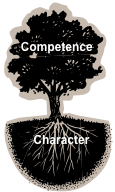Uh, what? Now, try reading the title of this article backwards, starting from the far right and reading to the left. It likely took you a few seconds to do that, going letter-by-letter to make the title out: "Riding a Backwards Bicycle".
You know, you've spent your whole life paving pathways in your brain to read from left-to-right. It's a well-ingrained habit that is difficult to change.
What about another ingrained habit, like riding a bike. What if a bike was set up "backwards" in some way? Could you ride it?
Take a few minutes to watch this entertaining video to learn more. You'll find the time well-spent and may even want to share it with your friends.
So what does this all of this have to do with strategic planning, leadership, management, and running a nonprofit? A ton. Essentially, building your organization's capacity is often about overwriting old habits with new ones. Just like learning to ride a different type of bike.
What are some of those old habits that you might like to change? Try these:
Writing strategic plans but not implementing them.
Waiting to the last minute to complete grants.
Doing more work in the evenings and weekends than you'd like.
Viewing funders as people that support you (versus people that you support too).
Providing the executive director with sporadic performance reviews.
Doing everything yourself and not delegating very effectively.
You may not view these as habits, but they are. They're individual and organizational habits. And, like the guy in the video, with some insights and a committed practice, you can change them.
Which brings me to an excellent resource for you if you'd like to learn more about changing habits: The Power of Habit: Why We Do What We Do in Life and In Business by Charles Duhigg. I read this book last year and have meaning to write about it ever since. It's fascinating. Duhigg provides a fantastic overview of how habits form and how you can change them. So, if you're serious about making changes in your life or organization, the concepts in this book are gold. The ideas will even help you ride a backwards bicycle if you'd like...







